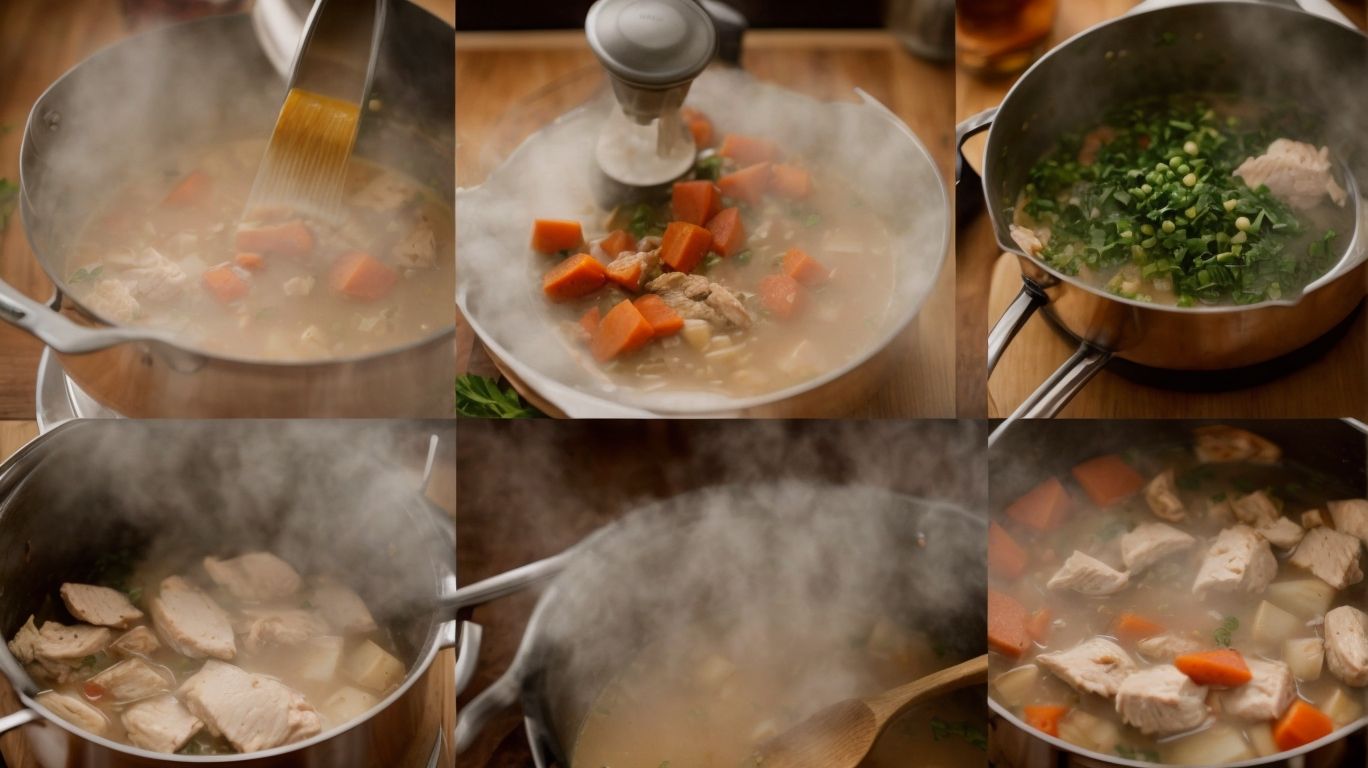How to Cook Chicken for Stew?
Are you looking to make the perfect chicken stew but not sure where to start? Look no further!
We explore the best types of chicken to use, how to prepare it for stew, the essential ingredients needed, and step-by-step instructions on how to cook a delicious chicken stew.
Whether you’re a seasoned chef or a beginner in the kitchen, these tips and tricks will help you create a flavorful and comforting dish that will surely impress your family and friends.
Let’s get cooking!
Key Takeaways:
What is the Best Chicken for Stew?
In terms of making the best chicken stew, choosing the right type of chicken is crucial for achieving that perfect balance of flavors and textures.
Chicken thighs, known for their tender and juicy meat, are popular choices for stews as they add richness and depth to the dish. On the other hand, chicken breasts, with their lean meat and mild flavor, bring a lighter element to the stew while still providing protein. In terms of chicken legs, their darker meat imparts a robust flavor and succulence, ideal for imparting a hearty taste to the stew.
By combining all three cuts, you create a stew with a delightful medley of textures and tastes. The thighs contribute moistness, the breasts offer a lighter contrast, and the legs infuse a bold flavor—resulting in a well-rounded and satisfying dish that’s sure to please any palate.
Chicken Thighs
Chicken thighs are a popular choice for chicken stew as they offer tender, succulent meat that absorbs flavors beautifully, making them ideal for creating a hearty and comforting dish.
One of the key advantages of using chicken thighs in stew recipes is their ability to stay moist and juicy even after long cooking durations, unlike chicken breasts which tend to dry out. Their higher fat content not only ensures a flavorful broth but also contributes to the overall richness of the stew.
The dark meat of chicken thighs brings a depth of flavor that elevates the entire dish, providing a more intense and satisfying taste profile compared to leaner cuts. The collagen present in chicken thighs breaks down during cooking, resulting in a velvety texture and a robust sauce consistency that coats each ingredient deliciously.
Chicken Breasts
Chicken breasts can also be used in stew recipes for a leaner option that provides ample protein and a healthier alternative for those watching their fat intake.
When incorporated into stews, chicken breasts offer a satisfying and nutritious meal choice. Their high protein content not only supports muscle growth and repair but also helps in keeping you full and satisfied for longer periods. Chicken breasts are a good source of essential nutrients like vitamin B12, selenium, and phosphorus, contributing to overall health and well-being.
For individuals looking for a lighter meal option without compromising on taste, utilizing chicken breasts in stews can be an excellent choice. This versatile ingredient can absorb a myriad of flavors from herbs, spices, and vegetables, enhancing the overall dish. Whether you opt for a classic chicken stew or experiment with international flavors, incorporating chicken breasts can elevate the nutritional profile and taste of your stew significantly.
Chicken Legs
Chicken legs, particularly drumsticks, can add a flavorful twist to chicken stew with their crispy skin and juicy meat, offering a satisfying eating experience for those who enjoy a combination of textures.
When preparing a stew, the drumsticks not only contribute to the dish’s flavor profile but also provide a visually appealing element, thanks to their distinct shape and presentation. The process of slow cooking allows the meat on these chicken legs to become tender and absorb the flavors of the stew, creating a harmonious blend of tastes. The juiciness of the meat from the drumsticks ensures that each bite is moist and full of flavor, making them a favored choice for many stew enthusiasts.
How to Prepare Chicken for Stew
Properly preparing the chicken for stew is essential to ensure that the meat is flavorful, tender, and perfectly integrated with the other ingredients in the dish.
Firstly, season the chicken with a blend of salt, pepper, and your choice of herbs and spices. This step not only adds depth of flavor to the meat but also helps tenderize it.
Next, marinate the chicken in a mixture of olive oil, garlic, and lemon juice to infuse it with additional layers of taste.
Lastly, browning the chicken in a hot skillet before adding it to the stew locks in moisture and creates a rich, caramelized exterior that elevates the overall dish.
Seasoning the Chicken
Seasoning the chicken for stew is a crucial step where the meat is infused with savory flavors from a blend of herbs and seasonings, adding depth and richness to the dish.
One of the keys to achieving a well-seasoned chicken stew is selecting the right combination of herbs and spices that complement each other. Garlic, thyme, and rosemary are classic choices that provide earthy and aromatic notes, while paprika and cumin add a touch of warmth and complexity.
A splash of soy sauce can introduce umami richness, enhancing the overall savory profile of the stew. Seasoning blends like Italian seasoning or Cajun spice mix can bring a unique twist to the traditional flavors, elevating the dish to a whole new level.
Marinating the Chicken
Marinating the chicken prior to cooking allows the meat to soak up delicious flavors, tenderize, and create a more nuanced taste experience in the final stew.
When chicken is marinated, the flavors from herbs, spices, and acids seep into the poultry, infusing it with rich taste. The marination process helps in breaking down the proteins, resulting in a more tender and juicy texture when cooked. Through marinating, the chicken gets transformed into a savory canvas, ready to elevate the overall dish to a new level of satisfaction. This step is crucial in achieving a well-balanced and flavorful stew that is sure to impress any palate.
Browning the Chicken
Browning the chicken before adding it to the stew not only creates a crispy, savory skin but also enhances the meat’s flavor through caramelization, adding depth to the overall dish.
This process starts by heating a heavy-bottomed pan over medium-high heat and adding a thin layer of oil. Once the oil shimmers, carefully place the chicken pieces skin-side down in the pan. The sizzle as the skin hits the hot surface is a satisfying sound that signals the beginning of flavor development.
As the skin crisps up, turning golden brown and releasing its delicious aroma, the sugars in the meat caramelize, creating a rich and savory foundation for your stew. The Maillard reaction, a chemical process that occurs during browning, is responsible for those complex, mouthwatering flavors that elevate your dish to a whole new level.
What Ingredients Do You Need for Chicken Stew?
Creating a flavorful and hearty chicken stew requires a combination of fresh vegetables, aromatic herbs, and a rich broth that serves as the foundation for a satisfying and comforting meal.
In terms of vegetables, classic choices like carrots, celery, and onions add depth and sweetness to the stew, while potatoes and mushrooms bring a hearty and earthy element. Garlic and shallots contribute a savory kick, enhancing the overall flavor profile.
- The key herbs like rosemary, thyme, and bay leaves infuse the stew with aromatic notes, providing a fragrant and robust essence that complements the poultry.
- For the broth, options range from homemade chicken stock to store-bought varieties, with each offering its unique complexity and richness to the dish.
Vegetables
An array of fresh vegetables such as root vegetables, carrots, celery, and onions can provide both flavor and nutrition to chicken stew, adding a colorful and wholesome touch to the dish.
Root vegetables like potatoes, turnips, and parsnips are not only hearty and comforting but also add a depth of earthy flavor to the stew. Carrots bring a touch of sweetness and vibrant color, while celery contributes a subtle, aromatic note. Onions, whether sautéed for a caramelized richness or added raw for a pungent kick, create a flavorful base for the stew.
By incorporating this medley of vegetables, you not only enhance the taste profile of the chicken stew but also boost its nutritional value. Root vegetables are rich in essential vitamins and minerals, while carrots are a great source of beta-carotene, important for eye health. Celery is known for its antioxidants and anti-inflammatory properties, and onions offer immune-boosting benefits.
Herbs and Spices
Aromatic herbs and spices play a vital role in seasoning chicken stew, enhancing its savory profile, and helping to thicken the broth to achieve a rich and flavorful consistency.
In terms of seasoning chicken stew, bay leaves are a popular choice for imparting a subtle earthy undertone, while thyme adds a floral and herbaceous note that complements the chicken’s flavor.
The warmth of cumin and the slight heat of paprika can provide a depth of taste and a hint of spiciness, elevating the overall taste profile of the stew.
Ingredients like garlic and onions not only enhance the flavors but also contribute to thickening the broth naturally as they release their oils and flavors during the cooking process, creating a luscious texture that coats the tender chicken pieces beautifully.
Broth or Stock
The choice between using homemade chicken stock or store-bought broth can significantly impact the overall taste and quality of the chicken stew, with each option offering distinct flavors and textures.
Homemade chicken stock is known for its rich, deep flavor, often attributed to the slow simmering of bones and vegetables, allowing the flavors to meld and develop over time. This results in a more complex and nuanced taste profile, enhancing the depth of the stew.
On the other hand, store-bought broth, while convenient, can sometimes lack the depth and complexity of homemade stock. It usually has a saltier taste and may contain additional preservatives or flavor enhancers.
Steps for Making Chicken Stew

Credits: Poormet.Com – Gerald Williams
Preparing a delicious chicken stew involves a series of steps, from sauteing the vegetables to simmering the flavorful broth with tender chicken pieces, resulting in a hearty and satisfying meal.
After sauteing the vegetables until they are tender and fragrant, the next step is to pour in the chicken broth along with the seasoned chicken pieces. This will infuse the stew with rich flavors and aromas, creating a mouth-watering dish that is perfect for any occasion. The stew should then be left to simmer gently, allowing all the ingredients to meld together harmoniously.
As the stew simmers, the flavors intensify, and the chicken becomes tender and juicy. It is essential to check the consistency periodically, adding more broth or allowing it to reduce further, depending on your preference. The key is to achieve a perfect balance of flavors and a thick, hearty consistency that will satisfy any appetite.
Sauteing the Vegetables
Sauteing a mix of vegetables like onions, carrots, and celery forms the flavorful base of chicken stew, releasing their natural aromas and enhancing the overall taste profile of the dish.
When sauteing these vegetables, the process involves heating a pan with olive oil until it’s shimmering but not smoking, then adding the finely chopped onions, carrots, and celery. The initial sizzle as they hit the pan is a sign that the veggies are starting to caramelize, unlocking their sweetness. Stirring frequently ensures even cooking and prevents burning, allowing the flavors to intensify. The onions turn translucent, the carrots soften slightly, and the celery becomes fragrant, creating a rich foundation of flavors for the stew.
Adding the Chicken and Broth
Adding tender chicken pieces and flavorful broth to the sauteed vegetables creates a harmonious blend of flavors, with the chicken absorbing the rich broth while the vegetables simmer to perfection in the stew.
As the stew cooks, the chicken tenderizes, infusing the broth with its savory essence. Meanwhile, the vegetables release their natural juices, enhancing the overall depth of flavors in the dish. The simmering process allows all the ingredients to mingle and meld, creating a cohesive and delicious final product. This slow cooking method ensures that the chicken remains succulent and the vegetables maintain their texture and distinct taste profiles, resulting in a comforting and satisfying stew.
Creating a well-balanced combination of ingredients is key to achieving a flavorful and hearty stew.
Simmering the Stew
Simmering the stew allows the flavors to meld together, creating a savory and aromatic dish infused with herbs and seasoning that permeate the chicken and vegetables for a delightful dining experience.
Simmering is a crucial cooking technique that transforms individual ingredients into a harmonious blend of tastes and textures. The gentle heat of simmering helps tenderize tougher cuts of meat, allowing the flavors to intermingle and develop depth.
Herbs and spices play a vital role in enhancing the stew’s taste profile. Whether it’s the earthy aroma of rosemary or the warm spice of cumin, each addition brings a unique dimension to the dish, elevating it to a new level of culinary excellence.
Adding Finishing Touches
Adding finishing touches such as a splash of heavy cream to the stew can elevate its richness and creaminess, while also helping to thicken the broth to achieve the desired consistency and texture.
By incorporating this final touch, the chicken stew transforms into a velvety, luxurious concoction that delights both the palate and the eyes. The heavy cream seamlessly blends with the savory flavors, imparting a silky smoothness that coats each tender piece of chicken and vegetable. This small but essential step lends a touch of sophistication to the dish, making it suitable for a cozy family dinner or a special occasion gathering.
Tips for Making the Perfect Chicken Stew
Crafting the perfect chicken stew involves following some key tips that can enhance the flavors and overall dining experience, such as using homemade broth, avoiding overcooking the chicken, and adding depth with wine or vinegar.
Homemade broth forms the foundation of a rich and savory chicken stew, infusing every bite with exceptional depth and complexity. To ensure tender and juicy chicken, it’s crucial to cook it just until it’s done, as overcooking can result in dry, tough meat that detracts from the dish’s appeal. Wine or vinegar are fantastic additions that introduce a delightful tanginess or subtle sweetness, elevating the overall flavor profile of the stew.
Use Homemade Broth or Stock
Opting for homemade broth in your chicken stew elevates the dish with a savory and rich flavor profile that store-bought alternatives may lack, enhancing the overall taste experience for a truly satisfying meal.
When you take the time to simmer a broth from scratch, you infuse your chicken stew with a depth of flavor unmatched by pre-packaged options. The homemade broth allows you to control the seasoning, ensuring a perfect balance for your taste buds. The slow cooking process extracts nutrients and minerals from the ingredients, enhancing the nutritional value of your stew. The complexity of flavors that the homemade broth lends to your dish creates a dining experience that is unmatched in its richness and satisfaction.
Don’t Overcook the Chicken
Avoiding the pitfall of overcooking the chicken in stew ensures that the meat remains tender, juicy, and flavorful, preserving its natural qualities and contributing to a delightful dining experience.
Properly timing the cooking of the chicken in a stew is crucial to achieve that perfect balance where the meat is cooked through but still succulent. When chicken is overcooked, it can become tough and dry, losing its texture and taste. To avoid this, it’s essential to follow recommended cooking times and temperatures based on the type and size of the chicken pieces being used.
By respecting these guidelines, you can elevate your stew from ordinary to extraordinary, ensuring each bite is a delectable experience.
Add Flavor with Wine or Vinegar
Injecting additional flavor into the chicken stew with the addition of wine or vinegar can introduce depth and complexity to the dish, enhancing its taste profile and offering a nuanced dining experience.
When choosing wine for your chicken stew, opt for a dry white wine like Chardonnay or Sauvignon Blanc to bring a fruity acidity that balances the richness of the stew. The wine not only tenderizes the chicken but also adds a subtle sweetness that marries well with the savory elements. On the other hand, vinegar, such as balsamic or apple cider vinegar, can add a tangy kick that cuts through the richness, brightening the overall flavor profile. These acidic components play a crucial role in balancing the dish and elevating the taste to a whole new level.
Frequently Asked Questions
1. How much chicken should I use for a stew?
To make a hearty chicken stew, I recommend using ½ pound of chicken per serving. This will ensure that there is enough protein in each bowl.
2. Can I use boneless chicken for stew?
Yes, you can use boneless chicken for stew. However, I recommend using bone-in chicken for added flavor and texture.
3. Should I marinate the chicken before cooking it for stew?
Marinating the chicken before cooking is not necessary for a stew. However, you can marinate it for 30 minutes to an hour for added flavor.
4. How long does it take to cook chicken for stew?
Cooking time will depend on the type of chicken and the size of the chunks. Generally, chicken takes about 8-10 minutes to cook in a stew.
5. Can I use chicken broth instead of water in my stew?
Yes, using chicken broth instead of water will add more flavor to your stew. I recommend using homemade chicken broth for the best results.
6. Do I need to brown the chicken before adding it to the stew?
Browning the chicken before adding it to the stew can enhance the flavor and create a more appealing color. However, it is not necessary and you can skip this step if you’re short on time.




